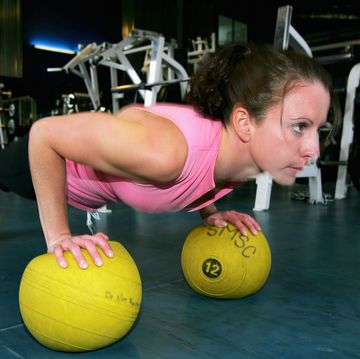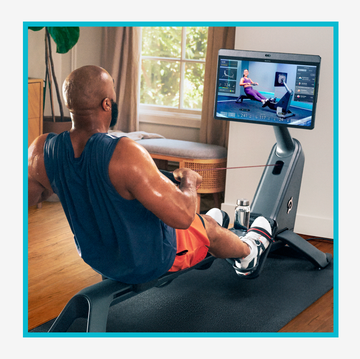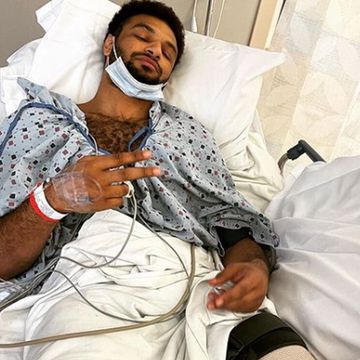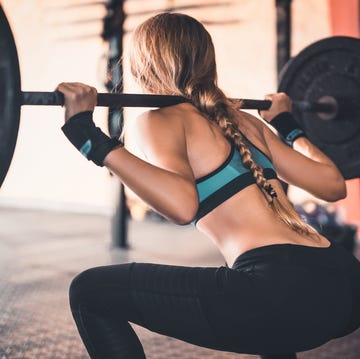You should be doing this exercise every day. "As women age, our muscles get weaker, and often one of the first things we struggle to do is get out of a chair. Think about it: How often have you seen someone lean forward and use their arms to pull themselves up, or worse, have to ask for help? To prevent that, you have to start strengthening your hip and thigh muscles now. I tell my friends to do 10 modified chair squats a day: Stand with your back facing a chair and your feet shoulder-width apart. Squat, hinging from your hips, until your butt taps the seat, then return to standing. You'll be grateful years from now, when you're the first person up from the table after a game of bridge." —Marianne Ryan, owner of Marianne Ryan Physical Therapy in New York City and spokesperson for the American Physical Therapy Association (APTA)
You can get PT for "down there". "Every now and then I'll hear a girlfriend make light of the fact that she has to cross her legs whenever she sneezes. I always tell her that urinary incontinence isn't a joke, nor is it something you have to live with! There are physical therapists who specialize in women's health, and they can help you strengthen your pelvic floor so you don't go through life leaking. Kegel exercises are a great start, but nearly 40 percent of women do them wrong: They squeeze their glutes, inner thighs, or abs instead of their pelvic floor. A physical therapist can teach you the technique as well as prescribe other therapies like electrical stimulation or biofeedback, which assist in correctly contracting the pelvic floor muscles, helping to make them stronger so they're better able to curb the flow of urine." —Jill Boissonnault, Ph.D., associate professor of physical therapy at the University of Wisconsin in Madison and spokesperson for the APTA
That pain won't get better on its own. "You can hurt yourself doing anything— even getting out of bed awkwardly—and too often women think their pain will magically go away. Sometimes it does! But usually that's because you've started to compensate for the pain by not allowing your body to move in a way that would hurt. For instance, if you injure your knee, you might put more weight on the opposite leg when you walk. That can help you feel better right now, but it can also lead to knee or hip pain in the other leg. It's a vicious cycle, and even physical therapists aren't immune: I've had to call out my coworkers for moving differently after torquing their backs or shoulders on the job. So if you find yourself in pain for a week or more, see a physical therapist (or your doctor, if you need a referral) and address the problem quickly, before it can become more serious." —Candy Tefertiller, director of physical therapy at Craig Hospital in Denver
Flip-flops are not your friend. "When I was pregnant, I wore flip-flops often because they're so easy to slip onto swollen feet. But they're really not meant to be worn all the time: They offer no arch support. Plus, your leg, toe, and foot muscles have to work harder to keep them on, which could make tendons tight and lead to pain that will affect your lower back. I encourage my friends to wear more supportive shoes whenever they're doing a lot of walking or standing—you don't want to put on flip-flops for an all-day trip to the amusement park— and to do foot and leg stretches to counter any tightening. My favorite is a runner's lunge: Stand with your hands against a wall and your feet about 12 inches from it. Step back with your right foot, then bend your left knee, keeping your back leg straight and your heel firmly on the ground. Hold for 20 seconds, and repeat on the other side." —Suzanne Badillo, clinical program director of the Women's Rehabilitation Program at the Rehabilitation Institute of Chicago
Encourage your kids to try lots of sports. "In the past, I didn't see kids for sports-related injuries until they were in high school. Now I'm treating children who haven't even hit their teens. There's been a cultural shift: Kids are being pushed by parents and coaches to specialize in one sport starting at a young age. The problem is, this often leads to stress injuries, as well as muscle imbalances. For instance, my friend's 11-year-old son is really good at soccer, but I had to tell her if he only did that, he could end up with really strong legs and a weak core. It's asking for trouble! I suggested he try other sports, but free play is equally important. Swinging from the monkey bars and climbing a jungle gym are great ways to develop motor skills and build strength all over." —Julie O'Connell, director of Performing Arts Rehabilitation at Athletico Physical Therapy in Chicago
Take it easy during your period. "A friend came to see me for pelvic and hip pain that had developed after she'd done a lot of lower body exercises like stepouts. During our conversation, she mentioned she was on her period. That's a red flag: There are a number of things that happen during menstruation that can cause ligaments and joints to loosen; your hormones are fluctuating, and often you're carrying excess fluid, too. Some women may feel the effects more than others. So I told my friend to lay off the high-impact workouts during the heaviest days of her cycle and instead focus on low-impact exercise, like biking or swimming." —Richard Sedillo, a physical therapist at Arizona Manual Therapy Centers in Scottsdale
Sometimes it really is mind over matter. "I had a friend who was experiencing neck pain and who was also under a lot of stress at her new job. I knew that working out was a huge tension reliever for her, so when she told me she had stopped for fear of making the pain worse, I was concerned. There's such a strong connection between stress and pain: Being in pain can make you even more anxious, and stress causes your muscles to tense up, leading to— guess what?—more pain. I reassured her that she wouldn't feel this way forever, but for the treatments to work, she needed to find an outlet for her angst, whether it was a class at the gym, yoga, or simply going for walks with a friend. She listened, and her condition really improved. Had she allowed the pain to disrupt her life, it would have been an uphill battle." —Mia Palazzo, program manager for physical therapy, occupational therapy, and the Sports Performance Center at the Center for Musculoskeletal Care at NYU Langone Medical Center
Not moving can lead to pain, too. "I've known people who were doing something as simple as hurrying up a flight of stairs when they suddenly felt a pulling sensation in their groin. And they told me, 'It just started. I don't know why!' Believe it or not, this often stems from spending too much time seated. We all know that sitting for hours at a time can contribute to back and neck pain, but it also shortens your hip flexors (the group of muscles that helps you lift your knees and move your legs), causing them to tighten. When you do get up, you may cause a strain. I tell my friends with office jobs to change their position at least once every 30 minutes— set a reminder on your phone. You can stand while on the phone, walk to a coworker's desk instead of emailing, or do some light stretches or exercises like calf raises." —Robert Gillanders, a physical therapist at Sports and Spinal Physical Therapy in Washington, DC, and spokesperson for the APTA













